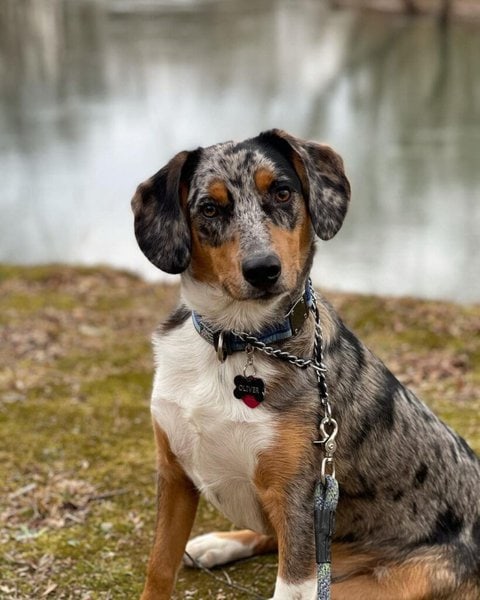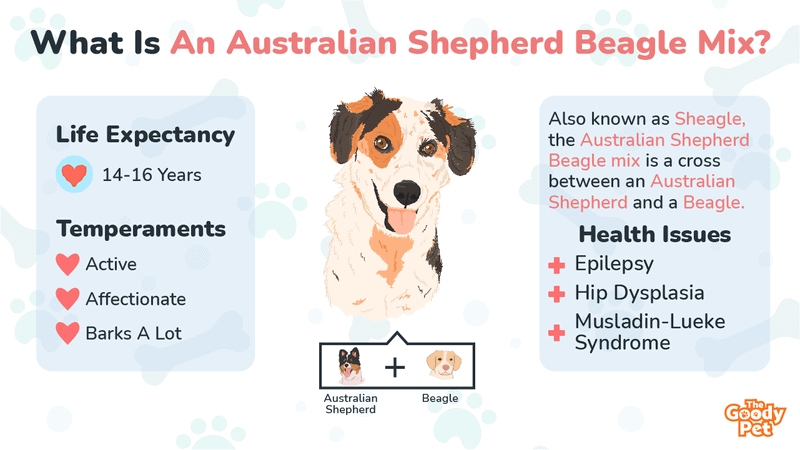As an avid fan of Beagles, do you sometimes wonder if the Beagle can come in a larger size, yet maintain its agility and high energy levels? Let us introduce you to the Sheagle, which may probably be an answer to your curiosity.
Bred from an Australian Shepherd and a Beagle, the Sheagle is a highly energetic and intelligent mixed breed that requires a load of exercise to ensure that they are not consumed by boredom. This dog would be ideal for an owner who is active and does not view physical activity as a chore but rather as a part of the natural part of their life.
Even though Sheagles are playful and naturally fun, they tend to be easily bored when they do not have a stimulus, which results in them indulging in destructive activities to quench their thirst for adventure.
We will be discussing everything that you should know about the Sheagle before deciding whether they are the correct breed for you.
What Is A Sheagle?
By bringing the agile Australian Shepherd and the active Beagle together, the Sheagle is the resultant hybrid mixed dog. Also known as the Aussie Beagle, the Sheagle is the next best thing to the Beagle.
Size
There are two variations of the Australian Shepherd breed and two variations of the Beagle breed. Both breeds have a standard and a miniature variation. Depending on the size of their parents, your Sheagle’s size will differ.
Generally, you can expect your Sheagle to be between 13 and 23 inches tall and weigh between 20 and 65 lbs.
Physical Appearance
Depending on which one of the parents’ genes is more dominant, the Sheagle could resemble the Australian Shepherd more than the Beagle or vice versa. However, Sheagles are generally medium-sized dogs who can have eyes and fur coats of various colors.
Possible fur colors of a Sheagle include red, white, brown, tan, fawn, and blue. Your Sheagle can either have long double fur coats, like the Australian Shepherd, or short fur, like the Beagle. It will also have a straight tail and floppy ears that droop to the jawline.

How Long Do Sheagles Live?
Sheagles typically have a lifespan of about 14 to 16 years.
Sheagles are generally healthy, but they are prone to contracting diseases that their parents are susceptible to, such as:
Hip Dysplasia
Hip dysplasia is a gradual impairment of the hip that occurs as your Sheagle grows. When your Sheagle is affected by hip dysplasia, the different components in the knee grow at different rates, instead of growing at a uniform rate.
This causes your Sheagle’s knee to loosen. Hip dysplasia is a genetic condition that is hereditary. It is very likely that your Sheagle will also have hip dysplasia, inherited from the parent breeds. Hence, dogs affected by hip dysplasia should avoid being used for breeding.
The symptoms of hip dysplasia include wobbliness, limping, pain in the hip, and reluctance to climb stairs. These symptoms can be observed in your Sheagle puppy when they are as young as a few months old.
If you suspect that your Sheagle may be affected, you should have them diagnosed as soon as possible so that your Sheagle may be treated. In mild cases, hip dysplasia can be treated by consuming some prescribed medication.
In more severe cases, your Sheagle would have to undergo surgery.
Epilepsy
Epilepsy refers to the occurrence of repeated seizures. These seizures may occur at regular or unpredicted intervals. Epilepsy is a genetic condition that is hereditary. Hence, if the parents had epilepsy, it is likely that your Sheagle will also have epilepsy.
The exact cause of epilepsy is still unknown. However, seizures typically occur at times when your dog experiences a change in brain activity such as waking up, falling asleep, feeding, or excitement.
Symptoms of Epilepsy include twitching, collapsing, drooling, foaming, tongue chewing, and stiffening. If your Sheagle is having a seizure, remain calm and try to carefully move them away from anything that may harm them.
You should not touch their mouth or try to feed them anything while they are in that state, they may bite you and you would end up doing more harm than good. To treat your Sheagle’s Epilepsy, your veterinarian will prescribe medication.
Musladin-Lueke Syndrome
Musladin-Lueke is a genetic disease that commonly affects Beagles. This disease affects the structure and development of connective tissue among several organ systems. It affects the heart, muscles, skin, and skeleton.
Beagles that are affected by Musladin-Lueke Syndrome are born with several physical defects, such as short outer toes, extra cartilage in their ears, narrow and slanted eyes, and unusually thick skin.
Unfortunately, there are no known treatments for Musladin-Lueke Syndrome. If your Sheagle is affected by this Musladin-Lueke Syndrome, it can be managed with supportive care.

How To Take Care Of Your Sheagle?
Exercise
Since both Australian Shepherds and Beagles are widely known for their energy levels and their roles as working dogs, the Sheagle requires a minimum of two hours of exercise every day.
The exercise may take the form of a lovely job with your Sheagle, such as a hike, obedience or agility training, or even a trip to the park. We would highly recommend playing with your dog. Sheagles are affectionate dogs who thoroughly enjoy spending time with their owners.
Diet
You should feed your Sheagle about 2 to 3 cups of food, split into two meals, daily. When you adopt your Sheagle puppy from a breeder you should ask the breeder what dog food your Sheagle has been eating.
You should continue feeding them the same dog food, in the same quantity for a few weeks and if you want to change brands, you should gradually introduce the change to your Sheagle puppy.
Numerous dog food brands offer high-quality, nutritional, and delicious dog food. One such brand is Pet Plate. Since Sheagles are highly active, you need to ensure that your Sheagle eats high-quality food to gain all the nutrients that they need to remain healthy.
We would recommend including nutritional supplements in your Sheagle’s diet. These supplements will allow your dog to get several vitamins and essential nutrients that are not included in its dog food.
Dog bodies are incapable of producing omega-3 fatty acids. Such acids are essential for your Sheagle’s growth because they support your dog’s heart, immune system, and joints.
Fish oil supplements contain omega-3 fatty acids. These supplements can easily be mixed into your Sheagle’s food for some added flavor and a nutritional boost.
Do Sheagles Bark A Lot? Temperaments Of Australian Shepherd Beagle Mixes
Sheagles are a very emotive breed with barking tendencies. They have a lot of emotions that they express through barking. Like the Australian Shepherd and the Beagle, the Sheagles barks a lot. This makes them ideal watchdogs.
Affectionate
Sheagles are a ‘pack’ breed, meaning that they need to be around their family for them to be content. Sheagles love being given attention by their family, as well as cuddles. With the appropriate training, Sheagles would make ideal family dogs.
The Sheagle breed cannot be left alone for too long. Aside from the fact that they may be lonely and sad, they will also be bored and find alternative ways to entertain themselves. These alternative ways usually involve them being destructive.
Trainability
Based on their level of intelligence, Sheagles would be easy to train. However, their stubbornness makes training them a bit tricky. Sheagles are also quite curious so they tend to be distracted quite easily.
To train your Sheagle, you need to find ways to stimulate their curiosity and keep them entertained. We suggest using reward-based methods. Whenever your Sheagle does well, you should praise them, rub their head or give them a treat.
Your Sheagle’s hard-headedness will probably frustrate you but the most important factor when training any dog is patience. You will be able to achieve better results by remaining calm and persistent, rather than using harsh methods to train your Sheagle.

Do Sheagles Shed? Grooming Tips For Australian Shepherd Beagle Mixes
Brushing
If you are opting to get a dog that experiences minimal shedding, then the Sheagle is not the dog for you. Sheagles shed a lot and even more so during the spring and fall.
You should brush your Sheagle at least 2 to 3 times a week. Sheagles generally have thick double fur coats, so brushing them will not be enough.
To ensure that you groom your Sheagle adequately, we suggest using the FURminator Undercoat Tool. This tool is able to work through the Sheagle’s thick fur coat and remove all loose hair and mats without harming your Sheagle.
Bathing
As the Golden Rule goes, you should bathe your dog only when it is necessary to not strip off the protective essential oils from the skin. However, since the Sheagle has such a thick and medium-length fur coat, you will have to bathe them more often than dogs with shorter fur coats, once every week or two.
When you bathe your Sheagle, you should use a cleansing and moisturizing dog shampoo. Pro Pet Works All Natural 5 In 1 Oatmeal Shampoo is an excellent pick for your Sheagle. This shampoo will cleanse and nourish your Sheagle’s fur and skin, leaving them clean and smelling fantastic.
Related Questions
How Much Is A Sheagle? The cost for a Sheagle puppy ranges between $400 and $1,000. Factors such as the eye color, fur coat, quality of the parents, and quality of the breeder will influence the price that you would have to pay for a Sheagle puppy.
Do Beagles And Australian Shepherds Get Along? The Australian Shepherd and the Beagle should get along quite well. Both the Australian Shepherd and the Beagle are friendly and sociable breeds who tend to get along with children and many other pets.
Do Australian Shepherd Beagle Mixes Swim? The Australian Shepherd is an exceptional swimmer and enjoys being in the water, while the Beagle can swim but often hates water. A Sheagle can swim but whether they actually enjoy swimming is a mystery that you would solve by yourself.





